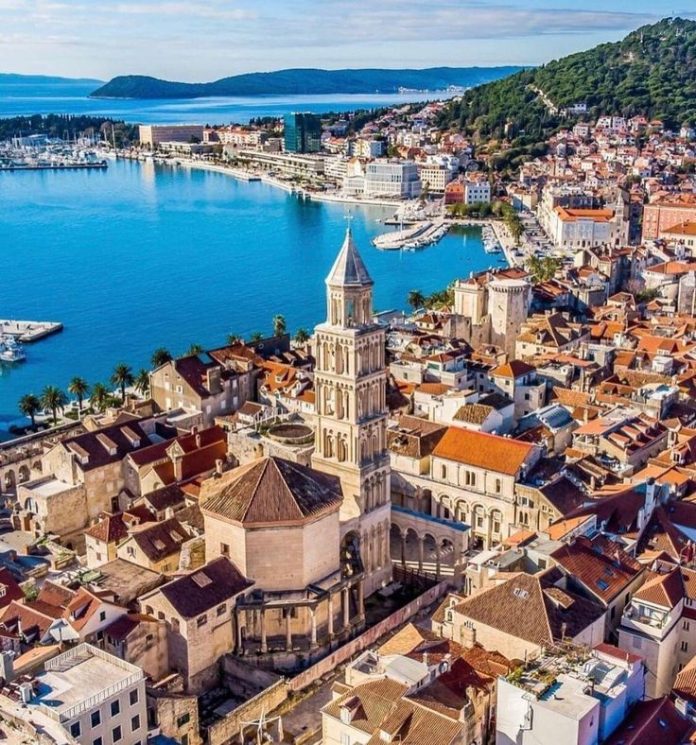By Slaven Vujić – Cultural Storyteller of the Adriatic
Most travelers come to Dalmatia with a checklist: beaches, sunshine, old towns, seafood.
But those who stay a little longer — who listen, walk, and wonder — discover something else.
They begin to hear the story the land is trying to tell.
This is a journey not for the rushed tourist, but for the curious soul.
A week where ruins speak, saints linger, and stones remember.
Day 1: Split – The Palace That Refused to Die
You don’t arrive in Split. You descend into it.
You step through the Iron Gate, and suddenly you’re inside a city that was never supposed to live this long. Stone corridors wind beneath laundry lines. Teenagers sip coffee on Roman thresholds. Grandmothers lean from Venetian windows carved into imperial walls. And the voice of the past? It doesn’t echo — it mutters, it whispers, it laughs.
Once, this was Diocletian’s retirement fantasy — a Roman emperor’s grand retreat from power. He filled it with columns from Egypt, limestone from Brač, and the finest architects in the empire. But Diocletian died. The empire fell. And the palace?
It survived — not as a relic, but as a refuge. When nearby Salona burned, the people fled into the palace. They built homes in its courtyards. Churches in its temples. Life in its bones.
And so it continues today.
Sit in the Peristyle at dusk when the stones start glowing like old embers. Walk the substructures beneath the palace and imagine the emperor pacing above your head. Touch a column that has seen everything — and still holds up the sky.
In Split, nothing is gone. It’s just layered.
Even time.
Day 2: Salona and Trogir – Cities of Silence and Stone
If Split is a survivor, Salona is a ghost.
You walk through wildflowers and ruined amphitheaters, past sarcophagi cracked by earthquakes and time. Salona was once the Roman capital of Dalmatia, home to 60,000 people — senators, bishops, martyrs. It had theaters, forums, baths, and basilicas. Now it has wind. Memory. And you.
Stand in the middle of the amphitheater and close your eyes. Hear the roar of the crowd. Then the silence. Then, maybe, a whisper from the past — “We were here.”
In the afternoon, drive toward Trogir, where history didn’t die — it calcified.
A small island wrapped in marble and myth, Trogir is a place where time didn’t pass. It folded.
You cross the bridge and enter a city of labyrinthine alleys and lion-guarded gates. Every stone house is a paragraph. Every courtyard — a pause in the sentence. The Cathedral of St. Lawrence rises at the center like a stone prayer.
If Salona broke your heart, Trogir will hold your hand and say: “Some stories are never lost. Just softened.”
Day 3: Brač – Stone, Saints, and Salted Air
The sea between Split and Brač is not wide, but the silence that greets you on the island feels like a different century. Here, the wind carries no rush. It tastes of pine, of salt, of something old that doesn’t care to explain itself.
You arrive in Supetar, where time takes its first step backward.
Follow the inland roads through olive groves and dry-stone walls, past villages where men still shape stone with their hands and women bake bread by memory. The road leads you to Pučišća — a place so white, so carved, it looks like it was built by the marble itself.
This is where the stonecutters live.
And not metaphorically.
In Pučišća, young students still train at Croatia’s only stonemasonry school, chiseling Brač limestone the way their ancestors did — carefully, rhythmically, almost reverently. You don’t just see tradition here. You hear it. In every tap of the hammer.
From there, rise up to Vidova Gora, the highest peak on any Adriatic island. Below you, like a crescent of gold drawn by Poseidon’s fingertip, lies Zlatni Rat — the Golden Horn, a beach that shifts with the tide like a creature breathing.
Brač is not loud. It doesn’t need to be. It was here before Rome, and it will be here after us.
Take a stone in your hand before you leave.
Not as a souvenir. As a reminder.
Day 4: Hvar – The Island That Dances with the Sun
You approach Hvar by boat, and it greets you the way a noblewoman might — smiling, radiant, but with something hidden behind her eyes.
Most travelers see only the brightness: the sun-drenched cafés, the lavender shops, the yachts. But if you look closer, you’ll see the shadows — and that’s where the real story lives.
Climb to the Fortica, the 16th-century fortress that watches the harbor like a sleeping lion. Its walls have seen pirates, plagues, wars — and still stand. From up there, Hvar looks like a stage. But what played here was real.
Descend into the Franciscan monastery, where the hush wraps around you like seawind through pine needles. The monks here still walk the cloisters, still pray, still tend to the silence as if it were a garden.
Then — if the season is right — find a lavender field. Not the touristy ones, but the wild ones, high in the hills. Stand in it. Breathe in a memory that was never yours… and yet feels familiar.
Hvar is a contradiction — light and shadow, sacred and seductive.
It doesn’t just charm you. It studies you.
Let it.
Day 5: Cetina Canyon – Where the River Remembers
By now, the sea is in your blood. But today, you turn inland. Toward the river that carved a kingdom, fed villages, and whispered to monks in the dark.
The Cetina does not rush. It slides between cliffs like a story that’s been told a thousand times and still isn’t finished.
You arrive in Omiš, a coastal town once ruled by pirates — not romantic ones, but hard, brutal men who knew the wind better than prayer. Their strongholds still crown the rocks above, and if you climb the staircases carved into the mountain, you can see what they saw: a river hiding in stone, and the sea beyond it like a promise or a threat.
Deeper inland, where the canyon narrows and the green gets thicker, the story changes. You raft or walk along the Cetina’s quieter parts, where old mills sleep and dragonflies trace spirals in the sun.
There’s a spring here — they say it’s sacred.
The kind of place where you don’t talk. You just let the water speak.
The Cetina does not just flow through Dalmatia.
It flows through its memory.
Day 6: Badija and Korčula – Islands of Silence and Stone
Some islands are loud — full of crowds, cocktails, hashtags.
Badija is not one of them.
You sail early, when the sea is still silver, and the island rises like a secret from the mist. There’s only a monastery here, a forest, and deer who stare at you like they’re guarding something sacred.
Walk the coast path slowly. The Franciscan monastery still holds mass in the chapel. You might hear it if the wind is right. You might feel it even if you don’t.
Then sail to Korčula, that proud walled city often called the “Little Dubrovnik.” But unlike her more famous cousin, Korčula doesn’t perform. She waits.
You walk under the Land Gate, and the stone streets curve upward like a spine.
They say Marco Polo was born here.
Whether or not that’s true doesn’t matter.
Because this is a place of departure — for explorers, for pilgrims, for those chasing meaning.
Some islands feed your body. These feed your inner quiet.
Let them.
Day 7: Return, Wander, or Begin Again
By now, something has shifted.
You don’t check your phone as much.
You listen more.
You notice things — the shape of old doorways, the way the sky blushes before sunset, how salt smells different in morning light.
Today, you return where your heart pulled hardest.
Or you find a small village you’ve never heard of.
Or you sit by the sea and simply do nothing — which in Dalmatia, is an ancient form of meditation.
Because this was never about “seeing everything.”
It was about hearing the story behind what you saw.
Dalmatia is not a destination.
It is a storyteller.
And if you let it —
it will tell you something you needed to hear.

